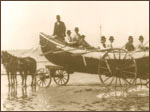| calendar | membership | store | search |

|
| Information | Exhibits | Programs | Races | Events | Get Involved | Home |
| Collections | History | For Researchers |
|
On the morning of November 25th 1888, Joshua James spotted six schooners anchored in Nantasket Roads, a half mile southwest of Boston Light. The first to run aground in the mounting storm was the Cox and Green, which struck rocks in mid-afternoon, half a mile from the Humane Society’s boathouse at Stony Beach. The breeches buoy was used to rescue all eight sailors aboard. Even before the last man was brought ashore from the Cox and Green, at about 8 pm the Gertrude Abbott was driven onto the rocks a half mile further up the beach. The lifesavers were able to set out in their surfboat only after darkness had fallen. At the wreck, the surfboat was maneuvered under the ship’s bow, and as the smaller craft was lifted by the cresting waves, the eight sailors leapt one by one from the rigging into the boat. The surfboat R.B. Forbes, with 13 crowded aboard, repeatedly filled with water and swamped once while returning to shore. Most of the oars were lost and one man was washed away and reclaimed before the surfboat itself was smashed on hidden rocks near the shore in a rescue that Joshua James called “miraculous.” All nine surfmen who affected this rescue were awarded the Treasury Department’s U.S. Gold Life Saving Medal, the highest possible award. At daybreak on the 26th, the surfboat Robert G. Shaw set out from the protected launch at Pemberton Point toward the Bertha Wa lker. The volunteers thus avoided some of the dangerous seas they had encountered going out to the Gertrude Abbott, but had to face an exceptionally difficult six and a half mile row to the wreck. Seven sailors from the ship were brought safely ashore by 9 am, all but the captain and first mate who had drowned during the night. Late in the morning of the 26th, word came that the H.C. Higginson was sunk between two ledges at Nantasket Beach, near the Bertha Walker. While the new surfboat Nantasket, designed by Samuel and Joshua James, was being towed up the Weir River and hauled over land to the ocean for use, men from the Cohasset Humane Society and the U.S. Life Saving Station at North Scituate at tempted to reach the ship with the beach apparatus. However, debris fouling the lines rendered the breeches buoy useless, and the Cohasset and Scituate crews left the wreck site. The Hull crew launched the Nantasket on her maiden rescue, but was forced back to shore 45 minutes later with two holes driven in her sides. After applying t emporary lead patches, the Hull volunteers successfully rowed out to the schooner. The ship's steward had died during the night, and the captain and mate had been swept overboard. It was said that the captain was too obese to climb the rigging, and that his mate had refused to leave him to perish alone. With the Nantasket at the Higgingson’s stern, the seamen stranded at the ship's bow lashed themselves to the tangled breeches buoy lines and leapt into the sea to be pulled to safety. By the afternoon of the 26th, the winds were easing, but the sea was running more heavily than ever. The schooner Mattie E. Eaton was driven so hard ashore that the crew was able to walk to safety at low tide. The brig Alice was abandoned at sea, but late on the 26th, the tireless Hull crew retrieved a salvager who had been stranded there when his dory was swept away. This was the last rescue of an extraordinary 36 hours, during which 28 Hull men had worked in five crews to save 29 lives along the town’s shores. This storm lead to the construction, one year later, of the Point Allerton U.S. Life Saving Station. |
|||||||||
| contact us | © 2004 Hull Lifesaving Museum | |||||||||
